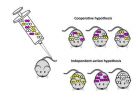(Press-News.org) Far beneath the surface of the ocean, deep currents act as conveyer belts, channeling heat, oxygen, carbon and nutrients around the globe.
A new study by the University of Pennsylvania's Irina Marinov and Raffaele Bernardello and colleagues from McGill University has found that recent climate change may be acting to slow down one of these conveyer belts, with potentially serious consequences for the future of the planet's climate.
"Our observations are showing us that there is less formation of these deep waters near Antarctica," Marinov said. "This is worrisome because, if this is the case, we're likely going to see less uptake of human produced, or anthropogenic, heat and carbon dioxide by the ocean, making this a positive feedback loop for climate change."
Marinov is an assistant professor in Penn's School of Arts and Sciences' Department of Earth and Environmental Science, while Bernardello was a postdoctoral investigator in the same department and has just moved to Southampton Oceanographic in the United Kingdom. They collaborated with Casimir de Lavergne, Jaime B. Palter and Eric D. Galbraith of McGill University on the study, which was published in Nature Climate Change.
Oceanographers have noticed that Antarctic Bottom Waters, a massive current of cold, salty and dense water that flows 2,000 meters under the ocean's surface from near the Antarctic coast toward the equator has been shrinking in recent decades. This is cause for concern, as the current is believed to "hide" heat and carbon from the atmosphere. The Southern Ocean takes up approximately 60 percent of the anthropogenic heat produced on Earth and 40 to 50 percent of the anthropogenic carbon dioxide.
"The Southern Ocean is emerging as being very, very important for regulating climate," Marinov said.
Along with colleagues, Marinov used models to discern whether the shrinking of the Antarctic Bottom Waters could be attributed to anthropogenic climate change.
They looked to an unusual phenomenon that had been observed from satellite images taken between 1974 and 1976. The images revealed a large ice-free area within the Weddell Sea. Called a polynya, this opening in the sea ice forms when warm water of North Atlantic origin is pushed up toward the Southern Ocean's surface. In a separate process, brine released during the sea-ice formation process produces a reservoir of cold, salty waters at the surface of the Weddell Sea. Because this situation is not stable, the heavy surface waters mix with the warmer, lighter waters underneath in a process called open-sea convection.
Polynyas were not observed again in the Weddell Sea after 1976, leading researchers to believe they –- and hence open-sea convection -– were rare events.
In the new study, however, the team suggests that polynyas were likely more common in the pre-industrial era, before anthropogenic climate change took hold.
The reason has to do with the fact that climate change has led to more precipitation around the Antarctic continent, both of which lead to greater levels of fresh water at the surface. Fresh water is more buoyant than saltwater and thus doesn't sink through the layers of the ocean as saltier water does, leading to fewer polynyas and less open-sea convection in the Southern Ocean.
"This is important because this process of deep convection that happens in polynyas is a big contribution to the Antarctic Bottom Waters, these deep currents that feed the rest of the ocean," Marinov noted.
Examining 20,000 data points, the researchers showed that the Southern Ocean surface has freshened during the last 60 years. They also found that vertical gradients of salinity and density have increased in the Southern Ocean, suggesting that mixing has been reduced.
Using the latest generation of climate models, 36 finely tuned and complex models that simulate climate change patterns, they found that, in most of the models, convective events, such as the polynyas captured by satellite images in the 1970s, were much more common in pre-industrial conditions, before anthropogenic climate change took hold.
"We see that the convective process is shutting down as the water gets fresher and fresher," Marinov said.
Seven of the models suggest that increased fresh water in the Southern Ocean could stop the convection from occurring altogether by 2030, and most models show strong decreases in convection during the 21st century, reducing the Antarctic Bottom Waters' formation.
This has implications for current and future climate change, the researchers said. The absence of polynyas in recent decades could mean that heat is getting trapped in the deeper ocean, possibly contributing to the recent "hiatus" in global atmospheric warming and the increase in Antarctic sea ice extent that have been observed in recent years.
But overall, Marinov said, "the slow down of polynyas will likely be a positive feedback on warming, as the convective process is shutting down and reducing the amount of new, anthropogenic carbon and heat being taken out of the atmosphere. We are pursuing these implications in our current work."
In a related paper, published this month in the Journal of Climate, Bernardello, Marinov and colleagues examine how the ocean's natural ability to store carbon might respond as the climate warms.
The ocean contains about 50 times more carbon than the atmosphere, making it a crucial but sometimes overlooked player in climate change regulation.
This ability, Marinov noted, stems in large part because of tiny organisms called phytoplankton that live near the ocean's surface.
"They are all microscopic so we don't see them, but they are mighty," Marinov said. "They account for 50 percent of the photosynthesis that occurs on the planet."
In conducting photosynthesis, the phytoplankton take up carbon, which is then passed down through the deep ocean layers as these organisms and the organisms that eat them die and decompose. If it were not for this process, atmospheric carbon dioxide levels would be about 200 parts per million higher than the currently observed 400 ppm.
The Penn-led team considered how wind, temperature and salinity may change during the 21st century and how these phenomena affect the natural ability of the ocean to store carbon.
Running climate simulations into the future, their findings suggest that the phytoplankton-driven biological carbon pump will strengthen, leading to increased carbon storage in the ocean. Yet this effect is not enough to outweigh the fact that a warmer ocean will not be able to hold onto as much carbon dioxide gas.
"Gases are more soluble in colder liquids," Marinov said. "With climate change we predict that the ocean will lose some of its deep, natural carbon in the future, partly because the temperature warming effect is so strong."
Looking ahead, Marinov plans to add to this complex picture of the ocean's role in climate change. She will participate in an effort to increase sampling from remote parts of the Southern Ocean, blending physical, biological and chemical analyses with further modeling.
"More and more, people interested in ocean and climate sciences must also be interested in interdisciplinarity, in linking physics, biology, chemistry in the global climate context," she said.
INFORMATION:
The research was supported by the National Oceanic and Atmospheric Administration, the Stephen and Anastasia Mysak Graduate Fellowship in Atmospheric and Oceanic Sciences, the Natural Sciences and Engineering Research Council of Canada, the Canadian Institute for Advanced Research, the Canadian Foundation for Innovation and Compute Canada.
Deep ocean current may slow due to climate change, Penn research finds
2014-03-21
ELSE PRESS RELEASES FROM THIS DATE:
Pushing and pulling: Using strain to tune a new quantum material
2014-03-21
Research into a recently discovered class of materials shows they have the necessary characteristics to develop ultra-energy efficient electronics. Topological insulators (TI) are three-dimensional materials that conduct electricity on their surfaces, while the interior insulates.
Their surfaces are particularly unique because the motion of the electrons is "protected" by symmetry, meaning electrons will keep moving without scattering even when they encounter defects and contamination.
In fact, electrons on the surface of TIs move so robustly scientists are trying ...
Computers spot false faces better than people
2014-03-21
TORONTO, ON — A joint study by researchers at the University of California San Diego and the University of Toronto has found that a computer system spots real or faked expressions of pain more accurately than people can. The work, titled "Automatic Decoding of Deceptive Pain Expressions," is published in the latest issue of Current Biology.
"The computer system managed to detect distinctive dynamic features of facial expressions that people missed," said Marian Bartlett, research professor at UC San Diego's Institute for Neural Computation and lead author of the study. ...
Characteristics of lung cancers arising in germline EGFR T790M mutation carriers
2014-03-21
DENVER –Two studies are providing new insight into germline epidermal growth factor receptor (EGFR) T790M mutation in familial non-small cell lung cancer (NSCLC). The findings suggest the need for tailored approaches for early detection and treatment, as well as for genetic testing to identify carriers.
"These studies now solidify the fact that routine clinical management of lung cancer now has to include the awareness of this inherited cancer syndrome," wrote David P. Carbone, MD, PhD, President-Elect of the International Association for the Study of Lung Cancer ...
Ground-improvement methods might protect against earthquakes
2014-03-21
WEST LAFAYETTE, Ind. — Researchers from the University of Texas at Austin's Cockrell School of Engineering are developing ground-improvement methods to help increase the resilience of homes and low-rise structures built on top of soils prone to liquefaction during strong earthquakes.
Findings will help improve the safety of structures in Christchurch and the Canterbury region in New Zealand, which were devastated in 2010 and 2011 by a series of powerful earthquakes. Parts of Christchurch were severely affected by liquefaction, in which water-saturated soil temporarily ...
Forests crucial to green growth
2014-03-21
NAIROBI, Kenya (21 March 2014) ----The value of forests and tree-based ecosystems extends far beyond carbon sequestration; they are the foundation of sustainable societies.
A new report, launched in Jakarta, Indonesia on 21 March - the International Day of Forests – promotes REDD+ and the Green Economy as together providing a new pathway to sustainable development that can benefit all nations. It claims this approach can conserve and even boost the economic and social benefits forests provide to human society.
Building Natural Capital – How REDD+ Can Support a Green ...
Pathogens in cheese
2014-03-21
Listeria is a rod-shaped bacterium highly prevalent in the environment and generally not a threat to human health. One species however, Listeria monocytogenes, can cause listeriosis, a very dangerous disease. This pathogen can be present in raw milk and soft cheeses, smoked fish, raw meat and ready-to-eat products. In Austria, health care providers are required to report all cases of listeriosis, which can be fatal particularly for patients with weakened immune systems. In 2009 and 2010, a dairy in Hartberg (Styria, Austria) produced Quargel cheese contaminated with Listeria ...
In rats, diffuse brain damage can occur with no signs of 'concussion,' reports study in Neurosurgery
2014-03-21
Philadelphia, Pa. (March 21, 2014) – A standard experimental model of concussion in rats causes substantial brain damage—but no behavioral changes comparable to those seen in patients with concussion, reports a study in the April issue of Neurosurgery, official journal of the Congress of Neurological Surgeons. The journal is published by Lippincott Williams & Wilkins, a part of Wolters Kluwer Health.
The results highlight the "disconnect" between preclinical and clinical studies of concussion, according to the report by Dr. Charles L. Rosen of West Virginia University, ...
Genetic evidence for single bacteria cause of sepsis identified for the first time
2014-03-21
An international team of academics, including Professor Marco Oggioni from the University of Leicester's Department of Genetics, has studied how localised infections can turn into the dangerous systematic disease sepsis – and has identified for the first time through genetic evidence that a single bacteria could be the cause.
The study, which has been published in the academic journal PLOS Pathogens, examined the events that lead to sepsis by Streptococcus pneumoniae (pneumococcus), a major human pathogen, in mice. They found that in most cases the bacteria causing sepsis ...
Lightweight construction materials of highest stability thanks to their microarchitecture
2014-03-21
This news release is available in German. KIT researchers have developed microstructured lightweight construction materials of highest stability. Although their density is below that of water, their stability relative to their weight exceeds that of massive materials, such as high-performance steel or aluminum. The lightweight construction materials are inspired by the framework structure of bones and the shell structure of the bees' honeycombs. The results are now presented in the journal PNAS, DOI: 10.1073/pnas.1315147111.
"The novel lightweight construction materials ...
New method can diagnose a feared form of cancer
2014-03-21
The poor prognosis for pancreatic cancer, where only 5 percent of the patients survive five years after the diagnosis, is due to the fact that the tumors often develop unnoticed, and rarely cause symptoms until they have spread to other organs. Recent studies, however, have shown that fluid-filled compartments in the pancreas, called cysts, may be precursors of the cancer.
Cysts in the pancreas, which are found in every 10th person above the age of 70, and are also common in younger people, can be discovered with computed tomography (CT) or magnetic resonance imaging ...




